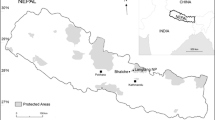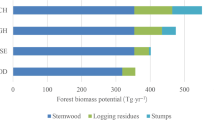Abstract
There is enough evidence to show that the forest biomass has decreased significantly in the Indian Himalayan state of Himachal Pradesh. The government has responded through restrictive measures to check this decline. Using tree biomass as proxy for degradation, we assessed the current state of biomass within dominant land use types and examined its implications for sustainability. The highest above-ground mean tree biomass density of 1158 t·ha−1 was recorded for the reserved forest followed by 728, 13, 11, 8, 5 and 3 t·ha−1 in the protected forest, fallow land, cultivated-unirrigated land, grassland, orchard land and cultivated-irrigated land respectively. Of the total accessible biomass, only 0.31% was extracted annually by the local people for fuel, fodder and other uses. Though, the current level of extraction may be sustainable in the short run, insufficient regeneration is observed for long term sustainability. Forest biomass production was simulated for the next 30 years with a logistic growth model and the relative significance of input variables in influencing system behaviour was analysed through sensitivity analysis. The model results highlighted the declining forest resources in the long run. Positive response through appropriate government policies can, however, change the scenario for the better.
Similar content being viewed by others
References
Anthra. 2001. Critique of the grazing policy for Anthra. Available at www.anthra.org/advocacy/Critique%20of%20the%20Grazing%20Policy.pdf) (viewed on September 25, 2006).
Awasthi A, Uniyal SK, Rawat GS, Rajvanshi A. 2003. Forest resource availability and its use by the migratory villages of Uttarkashi, Garhwal Himalaya (India). Forest Ecology and Management, 174: 13–24.
Bahuguna VK, Upadhyay A. 2002. Forest fires in India: policy initiatives for community participation. International Forestry Review, 4: 122–127.
Bhatt BP, Sachan MS. 2004. Firewood consumption along an altitudinal gradient in mountain villages of India. Biomass and Bioenergy, 27: 69–75.
Blanchez JL. 1997. Forest resources and roundwood supply in the Asia Pacific countries: Situation and outlook to the Year 2010. Working paper no: APFSOS/WP/17, Forestry Policy and Planning Division, FAO Rome, Italy.
Brooke A, Kendrick D, Meeraus A. 1996. GAMS Release 2.25: A User’s Guide. Washington, USA: GAMS Development Corporation.
Brown S, Gillespie AJR, Lugo AE. 1991. Biomass of tropical forests of South and South East Asia. Canadian Journal of Forest Research, 21: 111–117.
Chambers R. 1994a. The origins and practice of participatory rural appraisal. World Development, 22: 953–969.
Chambers R. 1994b. Participatory rural appraisal (PRA): challenges, potentials and paradigms. World Development, 22: 1437–1454.
Champion HG, Seth SK. 1968. A Revised Survey of Forest Types of India. New Delhi: Government Publication.
Chaturvedi OP, Singh JS. 1982. Total biomass and biomass production in P. roxburghii trees growing in all aged natural forest. Canadian Journal of Forest Research, 12: 632–640.
Ehrlich PR, Daily GC, Ehrlich AH, Matson P, Vitousek P. 1989. Global change and carrying capacity: Implications for life on earth. In: R.S. DeFries and T.F. Malone (eds.), Global Change and Our Common Future. Washington D.C.: The National Academies Press, pp. 19–28.
Farjon A, Nigel C. 1999. Conifers: Status Survey and Conservation Action Plan. Cambridge, UK: The World Conservation Union (IUCN).
FSI. 2002. The Manual of Instructions for Field Inventory, Forest Survey of India, Dehradun.
FSI. 2003. State of Forest Report 2003, Forest Survey of India, Dehradun, India.
GOHP. 2002. Himachal Pradesh Development Report, Government of Himachal Pradesh, Shimla.
GOHP. 2005. Management Plan of Chail Wildlife Sanctuary, Plan Period 1999–00 to 2008–09, H.P. Forest Department, Govt of Himachal Pradesh, Shimla.
GOHP. 2007. Himachal Forests: Forest cover by different forest types. Available at http://hpforest.nic.in/frst2.htm (viewed on July 9, 2007).
Gove JH. 2003. Estimations and application of size-biased distributions in forestry. In: A. Amaro, D. Reed, P. Soares (eds.), Modelling Forest Systems. CAB International pp. 201–212.
Gurung NR, Sankhayan PL, Hofstad O, Sitaula BK. 2002. Factors affecting forest volume and biomass at watershed level: A study in Annapurna conservation area, Nepal. Indian Forester, 128: 379–390.
HMG. 1988. Master Plan for the Forestry Sector Nepal: Forest Resources Information Status and Development Plan, His majesty’s Govt. of Nepal (HMG) Ministry of Soil and Conservation, Kathmandu, Nepal.
Ives J.D, Messerli B. 1989. The Himalayan Dilemma: Reconciling Development and Conservation. London: Routledge.
Jenkins JC, Chojancky DC, Heath LS, Birdsey RA. 2004. Comprehensive database of diameter-based biomass regressions for North American tree species. U.S. Department of Agriculture, Forest Service, Northeastern Research Station, Newtown Square, PA.
Kanagawa M, Nakata T. 2007. Analysis of the energy access improvement and its socio-economic impacts in rural areas of developing countries. Ecological Economics, 62: 319–329.
Karthikeyan A, Goraya GS, Kumar S, Kalia S. 2000. Studies on the mortality of Cedrus deodara in Chail forest (H.P.) and its causative factors. Indian Forester, 126: 1326–1332.
Kimothi MM, Jadhav RN. 1998. Forest fire in the central Himalaya: an extent, direction and spread using IRS LISS-I data. International Journal of Remote Sensing, 19: 2261–2274.
Kothari CR. 1990. Research methodology: methods and techniques. New Delhi: Wishwa Prakashan.
Kunwar RM, Sharma SP. 2004. Quantitative analysis of tree species in two community forests of Dolpa district, mid-west Nepal. Himalayan Journal of Sciences, 2: 23–28.
Luna RK. 1996. Plantation Trees. Dehradoon, India: Interanational Book Distributors.
Maikhuri RK, Rao KS, Patnaik S, Saxena KG, Ramakrishnan PS. 2003. Assessment of vulnerability of forests, meadows and mountain ecosystems due to climate change. Himalayan Ecology, 11: 1–9.
Moench M, Bandyopadhyay J. 1986. People-forest interaction: A neglected parameter in Himalayan forest management. Mountain Research and Development, 6: 3–16.
Monte-Luna Pd, Brook BW, Zetina-Rejón MJ, Cruz-Escalona VH. 2004. The carrying capacity of ecosystems. Global Ecology and Biogeography, 13: 485–495.
NSO. 1995. Technical notes on the 1995 household energy consumption survey. Available at http://www.census.gov.ph/data/technotes/notehecs95.html . (viewed on February 18, 2007).
Palm CA, Houghton RA, Melillo JM, Skole DL. 1986. Atmospheric carbon dioxide from deforestation in south-eastern Asia. Biotropica, 18 177–188.
Pohekar SD, Kumar D, Ramachandran M. 2005. Dissemination of cooking energy alternatives in India-a review. Renewable and Sustainable Energy Reviews, 9: 379–393.
Quazi SA, Ashton MS, Thadani R. 2003. Regeneration of monodominant stands of Banj Oak (Quercus leucotrichophora A. Camus) on abandoned terraces in the central Himalayas Journal of Sustainable Forestry, 17: 75–90
Rai SN, Chakarabarti SK. 1996. Demand and Supply of Fuelwood, Timber and Fodder in India, Forest Survey of India, Dehradun.
Ravindranath NH, Murthy IK, Chaturvedi RK, Andrasko K, Sathaye JA. 2006. Carbon forestry economic mitigation potential in India by land classification. Available at http://ies.lbl.gov/iespubs/61457.pdf . (viewed on March 10, 2007).
Rawat AS. 1999. Forest Management in Kumaon Himalaya. New Delhi: Indus Publishing Company.
Rawat YS, Singh JS. 1988. Structure and function of oak forests in central Himalaya I. Dry matter dynamics. Annals of Botany, 62: 397–411.
Renshaw, E. 1991. Modelling Biological Populations in Space and Time. Cambridge: Cambridge University Press.
Sankhayan PL, Gera M, Hofstad O. 2007. Analysis of vegetative degradation at a village level in the Indian Himalayan state of Uttarakhand — A systems approach by using dynamic linear programming bio-economic model. International Journal of Ecology and Environmental Sciences, 33: 183–195.
Sankhayan PL, Gurung N, Sitaula BK, Hofstad O. 2003. Bio-economic modeling of land use and forest degradation at watershed level in Nepal. Agriculture, Ecosystems & Environment, 94: 105–116.
Sankhayan, PL, Hofstad O. 2001. A village-level economic model of land clearing, grazing, and wood harvesting for Sub-Saharan Africa: with a case study in southern Senegal. Ecological Economics, 38: 423–440.
Saxena AK, Nautiyal JC, Foot DK. 1997. Analyzing deforestation and exploring policies for its amelioration: a case study of India. Journal of Forest Economics, 3: 253–289.
Sekhsaria P, Vagholikar N. 2004. Forced displacement from protected areas: The spectre looms large. Available at http://www.infochangeindia.org/features223.jsp (viewed on June 30, 2007).
Sharma A, Verma TD. 2000. Biology of Oak acorn weevil Curculio Sikkimensis heller (Coleoptera: curculionidae) in the mid hills of Himachal Pradesh. Indian Journal of Forestry, 23: 371–374.
Sharma ER, Pukkala T. 1990. Volume equations and biomass prediction of forest trees of Nepal. Publication No. 47 (1), Ministry of Forests and Soil Conservation, Forest Survey and Statistics Division, Kathmandu, Nepal.
Sharma RK, Sankhayan PL, Hofstad O, Singh R. 2007. Land use changes in the Western Himalayan region: a study at watershed level in the state of Himachal Pradesh, India. International Journal of Ecology and Environmental Sciences, 33: 197–206.
Shrestha BB. 2005. Fuelwood harvest, management and regeneration of two community forests in Central Nepal. Himalayan Journal of Sciences, 3: 75–80.
Singh DV, Sikka BK. 1994. Forest Farming Conservation, Production and Consumption in Rural India, In Special Reference to Social Forestry. Shimla: AERC.
Singh JS, Singh SP. 1992. Forests of Himalaya. Structure Functioning and Impact of Man. Nainital: Gyanodaya Prakashan.
Singh L, Lakhanpal TN. 2000. Cedrus deodara root rot disease-threat to the Himalayan forestry and environment. Indian Phytopathology, 53: 50–56.
Singh S, Kothari, A., Pande, P. 1990. Directory of National Parks and Sanctuaries in Himachal Pradesh, Indian Institute of Public Administration, New Delhi.
Singhal RM, Kumar S, Jeeva V. 2003. Forests and forestry research in India. Tropical Ecology, 44: 55–61.
Sitaula BK, Sankhayan PL, Bajracharya RM, Singh BR. 2005. A systems analysis of soil and forest degradation in a mid-hill watershed of Nepal using a bio-economic model. Land Degradation & Development, 16: 435–446.
Squiers ER, Wistendahl WA. 1976. Sample unit selection for studies of herbaceous oldfield vegetation. Ohio Journal of Science, 76: 185–188.
Sudha P, Ramprasad V, Bhat PR, Murthy IK, Rao RJ, Hedge GT, Nagaraja BC, Shastri CM, Nagendra MDV, Khan H, Shetty DM, Hegde GN, Murali KS, Ravindranath NH. 2006. Forest protection and regeneration under joint forest planning and management in eastern plains and Western Ghats of Karnataka, India. International Journal of Environment and Sustainable Development, 5: 70–84.
UNI. 2006. H.P. High Court bans tree felling. Available at http://www.indlawnews.com/1F848F38739C581669E6072617C77BE5 (viewed on December 1, 2006).
Usotsev VA, Hoffman CW. 1997. Combining harvest sample data and inventory data to estimate forest biomass. Scandinavian Journal of Forest Research, 12: 273–279.
Verma LR. 1988. Indigenous Technology knowledge for watershed management in Upper North-West Himalayas of India. Participatory Watershed Management Training in Asia (PWMTA) Program GCP/RAS/161/NET, FAO (UN) Kathmandu, Nepal.
Vetaas OR. 2000. The effect of environmental factors on the regeneration of Quercus semecarpifolia Sm. in central Himalaya, Nepal. Vegetatio, 146: 137–144.
WAC. 2006. Wood density database. Available at http://www.worldagroforestry.org/Sea/Products/AFDbases/WD/index.htm (viewed on September 7, 2006).
WECS. 2001. A country case study on wood energy planning: Nepal executive summary wood energy planning & analysis, Water and Energy Commission Secretariat, Kathmandu, Nepal.
Whitmore TC. 1984. Tropical Rain Forests of the Far East. London: Oxford University Press.
Author information
Authors and Affiliations
Corresponding author
Additional information
Foundation project: This work is financially supported by Norwegian University of life sciences, Aas, Norway (Sub Project Number 1526010, Main Project No. 11526010) and the Integrated Institute of Himalayan Studies (UGC Centre of Excellence), Shimla, India (Project Number 9–3/2005)
Rights and permissions
About this article
Cite this article
Sharma, R.K., Sankhayan, P.L. & Hofstad, O. Forest biomass density, utilization and production dynamics in a western Himalayan watershed. Journal of Forestry Research 19, 171–180 (2008). https://doi.org/10.1007/s11676-008-0032-5
Received:
Accepted:
Published:
Issue Date:
DOI: https://doi.org/10.1007/s11676-008-0032-5




